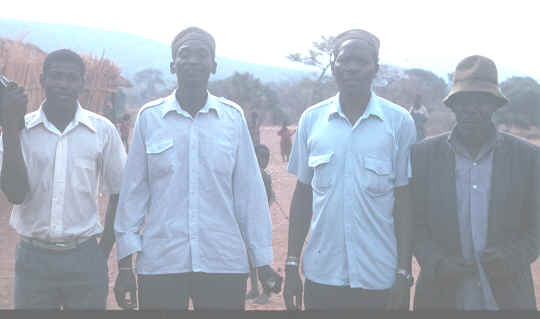|
Sungusungu Tribal Justice Organizations
|
Main Page | |||
|
Sungusungu
emerged among the Sukuma tribe as grass-roots law and order
organizations in 1982. Organizations were first formed with the goal of
controlling the increasing number of cattle rustlers because of the
Ugandan war in 1979 that produced a surplus of guns and young jobless
males. Soon the organizations began to punish adulterers, run-away
wives, debtors, and witches. Mesaki (1995) discusses how state officials
have documented 3,072 witch killings (approximately eighty percent of
the victims were elderly women) by the Sukuma from 1970-1988.
The Sungusungu revived traditional aggressive behavior towards
women and became heavily involved in the killings. Further, thieves,
whether they were guilty or innocent, were beaten and sometimes killed
after failing to confess their crime immediately. Although often
violent, Sungusungu are peacemakersócouncil members arbitrate
disputes involving debts or adultery with fines and sometimes ostracism.
Starting
in one or two villages, elders used charismatic leadership to organize
villagers into a rank-and-file hierarchy to combat crime and protect
cattle. Within a year, the organizations had spread from the Sukuma
populations in northwestern Tanzania to distant emigrant Sukuma
populations in areas such as Rukwa, where this research was conducted.
Bukurura (1994) and Abrahams (1998) discuss how the Sungusungu
institution involves independent village chapters whose activities are
coordinated by higher-level leadership. Although village Sungusungu
organizations have autonomy to choose their own leaders and make
decisions, the institution is set up to link all Sungusungu
chapters under one cooperating body. Leaders govern at the village,
ward, division, district and regional political levels following the
Tanzanian modern political system introduced by the British.[1]
Each of the political levels has Sungusungu officials including a
chief (ntemi), chairman (mwenyekiti) and a secretary (katibu). Sungusungu,
as the Sukuma did in pre-colonial times, depend on the ntemi as a
religious diviner. The chairman of the meeting holds a customary role
similar to Western institutions. He provides order within meetings, and
is the most likely person to be contacted by individuals requesting
assistance from the Sungusungu. The secretary uses the national
Swahili language to write the details of all the cases discussed at
meetings, and lists the names of every council member attending court
sessions. Under
the leadership positions, a few dozen or more council members (wajumbe)
have the duty of hearing cases and discussing Sungusungu matters
in secrecy. Each member is expected to attend meetings and participate
in court sessions. Further, if the secret committee fails to reach
consensus on a difficult case, a public meeting occurs where all Sungusungu
members are expected to attend. The Sungusungu soldiers are
composed of all young male Sukuma (between the ages of approximately 14
and 30) who are led by a few commanders. Each commander controls the
young males in approximately ten nearby households. The commanders and
soldiers are expected to obey the orders of the council and apprehend
thieves or other offenders immediately upon knowledge of a crime being
committed. Further, the soldiers may be asked by the council to travel
to distant areas to apprehend suspected offenders or gather witnesses
needed to resolve cases.
[1] Tanzania is divided into twenty-five regions. Each region is divided into a few districts, and subsequently divisions, followed by wards and village subdivisions. Each of these state political units of the state have both elected political officials as well as administrative assistants. REFERENCES Abrahams, R.G., and International African Institute 1967 The Peoples of Greater Unyamwezi, Tanzania Nyamwezi, Sukuma, Sumbwa, Kimbu, Konongo. London: International African Institute. Abrahams, R.G. 1998 Vigilant Citizens: Vigilantism and the State. Cambridge, UK, Malden, MA, USA: Polity Press; Blackwell. Bukurura, S. 1994 Sungusungu: Vigilantes in West-Central Tanzania. Cambridge: Cambridge. Fleisher, M.L. 2000 Sungusungu: State-Sponsored Village Vigilante Groups among the Kuria of Tanzania. Africa 70:209-228. Hangaya, M. 1989 The State and the Peasantry in Tanzania: Lessons from Sungusungu/Basalama of Shinyanga. University of Dar es Salaam. Mesaki, S. 1995 The Preponderance of Women as Victims in Sukuma Witch Killings. In The Tanzanian Peasantry: Further Studies, ed. Peter G. Forster, and Sam Maghimbi. xxxiv, 329. Aldershot, England; Brookfield, USA: Avebury. Mwaikusa, J.T. 1995 Maintaining Law and Order in Tanzania: The Role of Sungusungu Defense Groups. In Service Provisioning under Stress in East Africa, ed. J. Semboja, and O. Therkildsen. Copenhagen: Centre for development research. |
||||
|
|
||||
|
|
||||
|
|
||||

